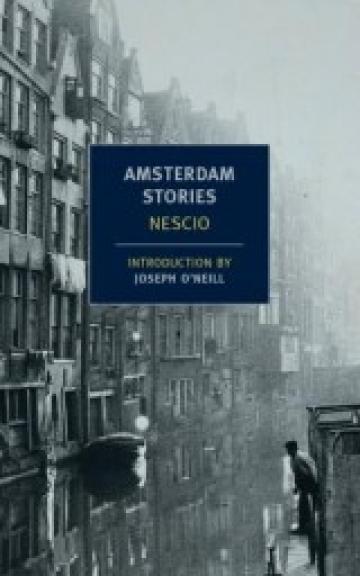AMSTERDAM STORIES by Nescio
Everyone has encountered the freeloader. He's the guy who was always hanging around, having a good time, never footing the bill or pitching in. He's the guy who, as Nescio describes him in his story “The Freeloader,” “always ordered in someone else's name, who sat and drank jenever like a prince at the outdoor tables of the Hollandais on other people's tabs . . . and took trips abroad whenever he'd hit up his old man for money again, and wore suits he never paid for.” He's shameless, artistic but not committed. When he fell in with a group of artists and writers, one of which is the narrator of the story, he was always present but never really doing anything productive; he simply consumed and observed. Who would know this type of character better than someone who understands the power of money?
Certainly no one would be able to capture him in a story the way that Nescio, a businessman-cum-writer did in “The Freeloader.” The multitalented Dutchman went by the pen name Nescio but was really J.H.F. Grá¶nloh, a successful director of the Holland-Bombay Trading Company, who created what many consider some of the greatest Dutch modern writing of the early 20th century. For years, Nescio's work remained inaccessible to the English-speaking world, and thus largely unacknowledged here, because nobody had translated it into English from the original Dutch. Then, recently, Damion Searls, a translator of German, French, Norwegian and Dutch who had previously worked on the German poetry of Rilke and Robert Walser among other great European writers, secured a grant from PEN American Center to translate Nescio's oeuvre into English.
The result of his efforts was a slim volume entitled Amsterdam Stories and published by New York Review Books. It's not at all what one might expect the life's work of a great author to be: a few short stories—some of which are a couple of pages or previously unpublished—and a fragment of a novel. But packed into these miniature works are gorgeous Dutch landscapes and plaintive portraits of young urban artists struggling to maintain a sense of awe about the world's beauty in the face of the dreariness of their urban professional lives.
In “The Freeloader,” Nescio's first and liveliest story, the main moocher's name is Japi and his nonchalance about life and money provides us with some serious amusement. But more interesting than his comedic value are the reactions he provokes in his artist friends. When the landscape painter of the group, Bavink, meets Japi on a boat, he's immediately taken with his refusal to give himself any occupation or titles. (Japi introduces himself by saying “'I'm not a poet and I'm not a nature-lover, and I'm not an anarchist. I am, thank God, absolutely nothing.'”) Bavink is even more enthralled when he finds out that Japi has a gift for remembering the minute details of natural scenery. He tells the narrator breathlessly that his memory for landscapes “borders on the miraculous,” even though it's clear that Japi has no desire or ability to garner any meaning from his observations. The narrator too is, at first, fascinated with Japi's ability to indulge in the good things in life—a fine cigar, a lively night on the town—in abundance without even a pang of guilt.
Japi's way of being, though, requires a constant stream of income and luxuries, all things that his artist friends claim are not important. Belying these dismissals of bourgeois comforts is the significant vexation of the artists when Japi robs them of their stuff. At the beginning of the third chapter lies the most brilliantly succinct expression of this: “And so when winter came to Amsterdam they came too, and Japi sat in my room one night and smoked the cigars sitting on my table for the taking, one after another. My cigars.” The narrator is furious.
But we don't exactly sympathize with him: we feel his emphasis on possession, and his rage seems petty, domestic, and counter to his grand artistic philosophy. These personal contradictions are the heart of all of Nescio's stories, especially “Young Titans,” “The Writing on the Wall,” and “Out Along the IJ,” whose tension comes from the contrast between the magnificence of art—nature's art—and the smallness of everyday urban life. Most striking in the stories, which have the same characters and narrator and so seem like chapters of one larger work, are the lyrical descriptions of natural landscapes, part of the poet narrator's ruminations of times spent around Amsterdam's dikes and canals and the surrounding countryside with his friends. Their mood is somber: we read renditions of the city's nature already marred by the disillusionment of the poet. Their clarity makes us believe in the essential beauty of Amsterdam's dikes with their “inquisitive cows,” the “little arrows of dancing gold that the sun made in the water,” the “fine white sand at the food of the dunes in Zandvoort,” the chestnut trees, and the red sky above it all.
But we also feel the dark presence of what Nescio called “the valley of obligations”—having to work in an office all day for jerk bosses, caring about money, wanting indulgences like elegant neckties and shoes—overshadowing the author's landscapes. Nescio's exquisite sense of modernity as an author precluded him from creating stories whose central conflicts could be resolved. His characters turn out to be failures either as artists—living sad lives as minor businessmen—or simply as functioning members of society; his natural world only gets tauntingly lovelier as its beauty is pulled into relief by the misery of modern life. His is a very bleak outlook, and it seems almost unfortunate that it should hold up so well in the work. It's also one that can easily turn into outright despair.
In the last story of the book “Insula Dei,” set in 1942, the two old protagonists deal with their new war-torn country by retreating into the past. The story is full of humble elegies of the land destroyed during the Second World War. “‘I can see myself biking between Naarden and the Hakkelaar bridge. June 1904. June 1904, just think back to that if you can. The sun was low in the sky, the water in the canal was totally still and reflected the reeds. The grass was growing between the stones.'” By the time we reach the last story we know that the destruction of the natural world is the worst thing that could happen to the author's characters. Without its provocative influence, Nescio tells us throughout the book, there's little chance that they can stay vibrant, sensitive, and human.
Meanwhile, we find ourselves caring deeply about their fate—not only because their lives, even while lived at the beginning of last century, still resonate with us, but also because Nescio has so much compassion for his characters it makes it difficult for us not to care. We're surprised by this compassion—it's not a trait that we associate much with businessmen and post-war novelists. But it's welcome. Even though Nescio's tragic dilemmas are hard to bear, they are deeply and closely felt—and this is what you will most likely end up remembering about this idiosyncratic Dutch author after your first introduction to his work and world.
Jan Hendrik Frederik Grá¶nloh was born in Amsterdam in 1882. He began work at the Holland-Bombay Trading Company in 1904 and became its director in 1906. In his spare time, under the guise of the pen name Nescio (Latin for “I don't know”), he produced what many consider the best modern writing in the Dutch language. He revealed his true identity in 1929 and retired from his business career a few years later. He died in 1961 in Hilversum, the Netherlands.

 Alexia Nader is a freelance writer from Miami who is now living in New York. She is currently a graduate student in the Cultural Reporting and Criticism program at New York University, and has contributed to the New Yorker, Smithsonian, and the Village Voice.
Alexia Nader is a freelance writer from Miami who is now living in New York. She is currently a graduate student in the Cultural Reporting and Criticism program at New York University, and has contributed to the New Yorker, Smithsonian, and the Village Voice.